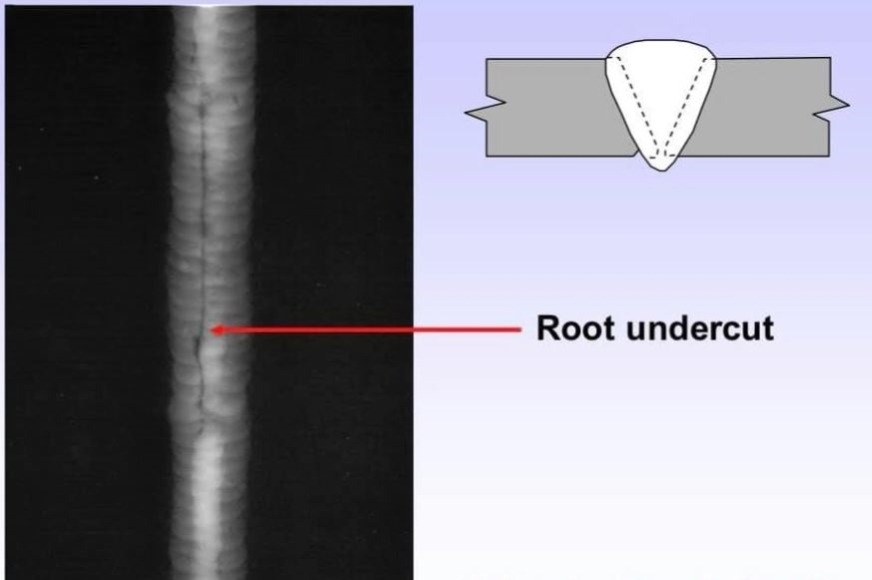How to Avoid Weld Undercut: Necessary Tips for Welders
How to Avoid Weld Undercut: Necessary Tips for Welders
Blog Article
Comprehending the Causes and Solutions for Undercut Welding in Metal Construction Procedures
In the world of steel manufacture procedures, the event of undercut welding poses a considerable difficulty that demands a detailed understanding of its reasons and viable solutions. The elaborate interplay of different elements throughout welding procedures can cause this unfavorable sensation, affecting the architectural honesty and total top quality of the bonded joints - Preventing weld undercut. By studying the origin of undercut welding and discovering reliable restorative procedures, producers can boost the requirement of their handiwork and make certain the manufacturing of perfect metal components
Common Causes of Undercut Welding
Regularly forgotten in steel construction, undercut welding happens due to numerous aspects that require precise attention and experience to be properly alleviated. One typical source of undercut welding is extreme warmth input. When the heat input is expensive, it can bring about the melting and succeeding disintegration of the base product along the edges of the weld joint, developing a groove or undercut. In addition, incorrect welding techniques, such as making use of the wrong welding angle or take a trip speed, can also add to undercut development. Inadequate securing gas coverage is an additional essential variable that can lead to damaging. Inadequate gas insurance coverage stops working to shield the weld pool sufficiently, leading to oxidation and undercut flaws. Moreover, the option of welding criteria, such as voltage, present, and cord feed speed, plays a considerable duty in the occurrence of undercut welding. Understanding these typical reasons is essential for carrying out preventive steps and making certain top quality welds in steel manufacture processes.
Influence of Incorrect Welding Parameters
Inaccurate welding specifications can dramatically compromise the stability and top quality of welded joints in metal manufacture processes. The effect of wrong welding parameters materializes in numerous ways, leading to architectural weak points and issues in the welded elements. Thorough attention to welding specifications is extremely important to ensure the production of high-grade welds with the desired mechanical homes and architectural honesty.
Effect of Improper Torch Angle
Incorrect lantern angle in welding procedures can significantly affect the high quality and honesty of the last weld joints in steel construction processes. The torch angle plays a crucial role in establishing the heat input and distribution during welding. When the torch angle is incorrect, issues such as undercutting can occur. Undercutting is a typical welding problem where a groove develops along the weld toe, compromising the joint and jeopardizing its structural integrity.
A lantern angle that is also high can lead to inadequate infiltration, insufficient combination, and enhanced spatter. On the other hand, a lantern angle that is too shallow can cause too much infiltration, burn-through, and distortion of the base product. Preventing weld undercut. Appropriate torch angle is important for ensuring regular weld high quality, strength, and look
To protect against damaging and other defects brought on by incorrect torch angles, welders have to be trained to maintain the proper lantern angle throughout the welding process. Normal surveillance and modification of lantern angles throughout welding can assist achieve audio welds with marginal problems.
Function of Inadequate Welding Techniques

One more facet of inadequate welding strategies is inappropriate weld prep work. Inadequate cleansing of the base steels, inaccurate joint layout, or not enough side prep work can all add to undercut welding. Insufficient securing gas coverage or using the wrong type of gas can result in insufficient combination and the formation of undercut defects.
To address the duty of insufficient welding methods in metal manufacture procedures, it is vital to offer comprehensive training for welders. Correct education and learning on welding specifications, joint preparation, and securing gas choice can help protect against undercut welding and make sure top quality welds in steel construction projects.
Reliable Solutions for Undercut Welding
Attending to undercut welding in metal manufacture needs implementing efficient solutions to boost weld high quality and architectural stability. Among the main solutions to battle undercut is to adjust welding criteria such as voltage, present, and take a trip speed to make certain appropriate warmth input and combination. By fine-tuning these setups, welders can stop extreme melting of the base steel and filler product, reducing the chance of undercut formation.
In addition, appropriate joint prep work is essential in protecting against undercut. Making sure tidy base metal surface areas without impurities and utilizing the ideal bevel angle can assist advertise better weld infiltration and reduce the danger of undercut - Preventing weld undercut. Using suitable welding methods, such as oscillating the torch or weaving, can additionally aid in distributing warmth evenly and filling up the weld joint appropriately, reducing the opportunity of undercut issues
Additionally, choosing the proper welding consumables, consisting content of electrodes and filler metals, is vital in minimizing undercut. Using materials with proper chemical make-ups and mechanical residential properties can add to attaining audio welds with marginal undercut. Regular examination and quality control measures should also be executed to discover and attend to undercut problems immediately, making sure the total honesty of produced metal elements.

Final Thought
To conclude, comprehending the causes and solutions for undercut welding in steel manufacture procedures is critical for attaining high-grade welds. By resolving typical causes such as inaccurate welding parameters, improper lantern angle, and poor welding methods, welders can stop undercutting and guarantee solid, sturdy welds. It is helpful hints vital to take notice of these elements and execute effective solutions to boost the total welding procedure and final product top quality.

Report this page